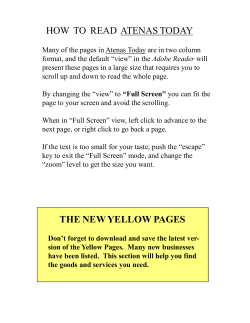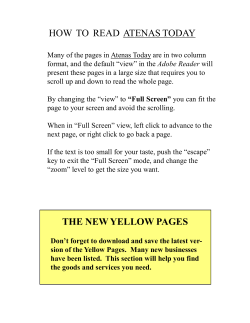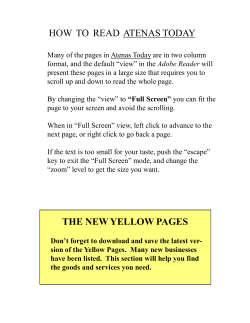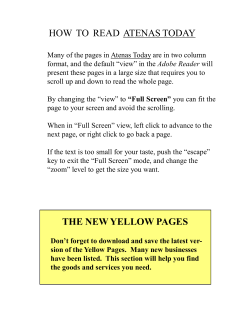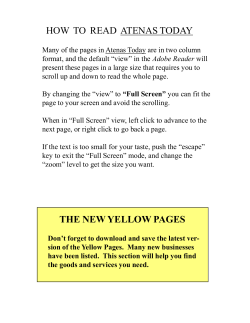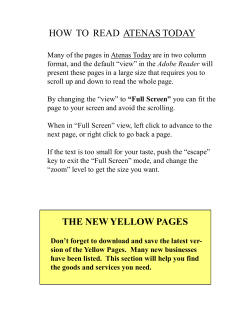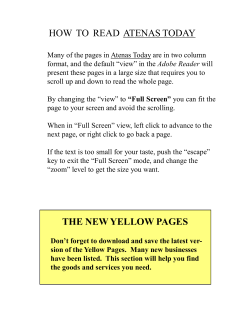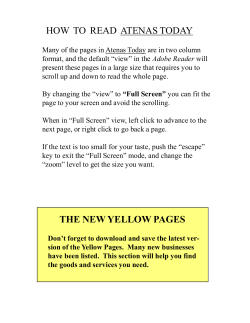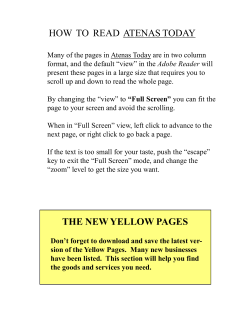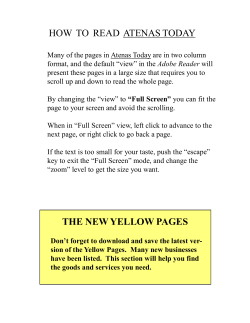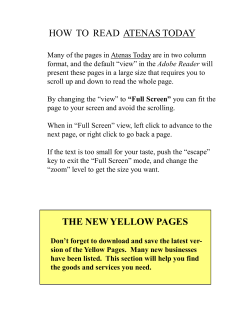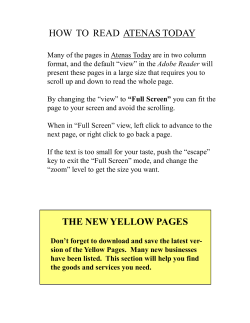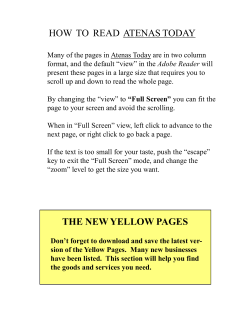
HOW TO READ ATENAS TODAY
HOW TO READ ATENAS TODAY Many of the pages in Atenas Today are in two column format, and the default “view” in the Adobe Reader will present these pages in a large size that requires you to scroll up and down to read the whole page. By changing the “view” to “Full Screen” you can fit the page to your screen and avoid the scrolling. When in “Full Screen” view, left click to advance to the next page, or right click to go back a page. If the text is too small for your taste, push the “escape” key to exit the “Full Screen” mode, and change the “zoom” level to get the size you want. THE NEW YELLOW PAGES Don’t forget to download and save the latest version of the Yellow Pages. Many new businesses have been listed. This section will help you find the goods and services you need. ATENAS TODAY Issue No. 74 February 24, 2011 In This Issue: Richard Sheppard — Identified Flying Object Gordon Klatt — Computer Malware, etc. Atenas News Marietta Arce — Flinstones and Me Art Gallery Theresa Fulton — Genetic Engineering Yoga Workshop Saving the Turtles Jim Craft — A Valentine’s Thought Bettie Nebergall — Too Clean ATENAS TODAY is a free English language newsletter for the residents and potential residents of Atenas, Costa Rica. It contains informative articles and creative compositions submitted by our readers, and is distributed via email approximately once a month to over 400 email addresses. To get on the distribution list or to submit material, please send an email to Fred Macdonald at fredmac222@yahoo.com. Display Advertising Argentinian Wines Finca Huetares CRWIFI Advertising rates and policies p. p. p. p. p. p. p. p. p. p. 3 5 7 8 9 12 17 18 19 20 p. p. p. p. 16 16 23 23 Compositions from back issues are archived on the Atenas Chamber of Tourism and Commerce website, www.atenascatuca.com. Click on the English version and then Atenas Today on the business page. DIRECTORY OF ENGLISHSPEAKING PEOPLE IN THE ATENAS AREA New names and numbers have been added to the directory. With each issue Atenas Today subscribers will receive an updated file containing the names and contact information of people who have chosen to be listed. Simply download the PDF file attached to this Atenas Today email and print it or save it on your computer. If your name is on the list without contact information, it is because you are a subscriber to the newsletter, but have not authorized the publication of your email address or other information. To add or correct data please send an email to fredmac222@yahoo.com. Identified Flying Object by Richard Sheppard The orbit of Venus around the sun is smaller than that of the Earth, so from our perspective on the Earth, Venus is always close to the sun. W e have to look in the direction of the sun to see it and it is never more than about 45 degrees from the sun. We call it The Morning Star or The Evening Star. It leads the sun as it rises in the East or it follows the sun into the western horizon. You will never see Venus at midnight. It takes 3 hours for the sky to rotate 45 degrees, so the absolute earliest we see Venus in the morning is 3am because in Atenas the sun comes up at about 6am. So the maximum time it is in the morning nighttime sky is 3 hours. The same is true when it is the Evening Star. The latest Venus sets is 9pm. Sunset is at 6pm, so again a maximum of 3 hours in the nighttime sky. The majority of the time Venus is up there it is in the daytime, accompanying the sun across the sky. But, luckily, Venus is so bright that we can see it in the daytime. Only the sun and moon appear brighter. Venus takes about 19 months to complete one cycle in the sky. Let’s start when Venus is first visible in the east at dawn. It will be just above the horizon as the sun is rising. Each morning thereafter Venus rises a little earlier and rises a little higher in the sky. After about 2 months Venus is rising about 3am and is about 45 degrees above the horizon as the sun rises. That’s as high as it gets at night. Then for the next 6 months each night Venus rises later and is seen lower in the sky in the dawn twilight. This is the part of the cycle we are in right now. Look to the east just before dawn. That bright object that looks too bright to be a star is Venus. More than half of all UFO reports turn out to be Venus. To help the illusion, Venus doesn’t twinkle and passing clouds sometimes make it look like it is moving. Venus will be in our morning star for about 5 more months. It will then disappear into the glare of the sun and be absent for 12 weeks. Venus is next seen just above the western horizon as the sun is setting. Each evening thereafter it sets a little later and is a little higher in the sky at sunset. After about 2 months Venus is about 45 degrees above the horizon as the sun sets and doesn’t itself set until about 9pm . Then for the next 6 months each night Venus sets earlier and is seen lower in the sky at dusk. After that Venus is again lost in the glare of the sun, this time for just 2 weeks. Go to http://www.panix.com/~ddellutr/astro/dvcvenus-synodic.htm for a good graphical representation of the cycle. To sum up: (1) Venus is the morning star for 8 months, never getting more than about 45 degrees (3 hours) ahead of the sun. (2) It is not seen for 12 weeks as it goes behind the sun. (3) It is the evening star for 8 months, never trailing the sun by more than 3 hours (45 degrees). (4) It again disappears into the sun’s glare this time for just 2 weeks. And the cycle repeats (19 months total). TECH TALK By Gordon Klatt Malware of the Month I've received a lot of calls recently about computer viruses. We all know that we have to have software on our computers to protect us from attack. In addition to viruses, we now have spyware and malware, trojan horses and rogues. Two people called about a program called Security Shield that kept popping up on their computers. Security Shield is rogue anti-spyware, that is, it appears to be anti-spyware software, but it's not. It attacks a computer when an unsuspecting user is surfing the internet and a pop-up appears saying that threats have been found on the computer, and offers a free scan to check for problems. Accepting the free scan installs the rogue program. It looks legit, and reports several 'threats' which can be removed after purchase. The threatening files it reports are actually Windows files and are not a threat at all. Security Shield also makes modifications that will cause it to launch when the computer is turned on, and starts blocking you from using other legitimate programs. It can also block the use of anti-spyware software, so successfully removing it is tricky, but possible. I used two different utilities to remove Security Shield, RKill, and Malwarebytes' Anti-Malware (both free). Of course prevention is the best cure, so remember that the only message about threats on your computer should come from legitimate anti-virus/spyware software that you installed. Never accept an internet offer for a free scan of your computer. Motorola Atrix = Phone + PC At the Consumer Electronics Show last month Motorola introduced a new dual core smartphone that contains an extra surprise: a piece of software that allows it to function like a full PC when connected in one of three docking modes: * Desktop PC mode with keyboard, mouse, and display * TV mode with a remote * Laptop mode, with a special laptop-like dock The Motorola Atrix sells for $199. To learn more about it, click here: http://www.motorola.com/Consumers/US-EN/Consumer-Product-andServices/Mobile-Phones/Motorola-ATRIX-US-EN POP3 vs. IMAP POP3 (Post Office Protocol) and IMAP (Internet Message Access Protocol) are two different email protocols. Both allow you to access your email, but which one to use? POP3 is useful if you access your email from one computer. If you access email from multiple devices, a desktop computer, a laptop, your phone, and use an email client like Outlook or Thunderbird, IMAP is the preferred choice. It's a server-based protocol and allows you to synchronize you messages between devices. So any message sent or received by one device appears on the others. Among the big three email providers, Google Gmail and Microsoft Hotmail/Live Mail have better IMAP capability. Yahoo Mail falls a bit short. If you don't use an email client to download and send email, which protocol you use doesn't matter. Windows Live Photo Gallery Windows 7 includes a group of programs called Live Essentials. Photo Gallery is one of the components. It's a photo organizer like Google's Picasa. And like Picasa, it offers some useful and easy to use editing functions, and lets you easily reduce and send photos as email attachments. One feature I like is creating a panoramic photo out of multiple shots. I've used Photo-Stitch, a utility included with Canon cameras, to combine photos, but I think Photo Gallery does a better job. Here's an example using three shots I took at Poas Volcano a couple of weeks ago. If you have a question, or suggestion for a future article, send me an email at gtklatt@live.com. ATENAS NEWS Residents Protest Closed Access Road The following is a translation of a report from Gilberto Luna about the protest meeting: "Residents of Atenas gathered at the Central School, with representatives of the Ombudsman's Office, members of congress, local leaders, the Mayor and City Council members of Atenas, to present a manifesto that demands the immediate and urgent reconstruction of the access road to Route 27 (Radial Atenas), allowing the normalization of the traffic flow in this community. In addition, they are requesting the elimination of the toll on Route 27, and the construction of two pedestrian bridges: one in Balsa and one in Rio Grande. February 28 is the deadline established "to receive a specific and effective response to these demands" from the government. After this date, other measures might be taken.” Recycling To Begin Again in Atenas After nearly a year with no downtown location for recycling, the municipality is establishing a drop off point in the park where on the first Wednesday of every month residents can bring paper, plastic, glass, and metal for recycling. Volunteers are needed to help with the work. Interested parties should contact either Anna in the municipality (Spanish speaking), or Marietta Arce (8395-3923, English speaking) Climate Fair Planning Under Way The 2011 Climate Fair in the park will be held on April 8 through April 11, with vendor tents, entertainment, and the annual oxcart parade. Contact Marietta Arce (8395-3923) for details. New Cafe Opens The Cafeteria Terra Nostra is now open under new ownership. It is located in the building in front of ICE, next to Miranda Hardware. New Service Phone Numbers Collect Calls - Costa Rica Collect Calls - International Directory assistance - Costa Rica Directory assistance - International ICE - report electricity problems ICE - report telephone problems ICE - RACSA dial up connection International operator calls 1110 1175 1113 1024 1026 1119 1134 1116 The Flintstones, The Jetsons and Me! by Marietta Arce One of the many changes my family experienced when we moved to the U.S. in late 1963 was the acquisition of a television set. In our middleclass neighborhood in San José, only one of my friends had such an item and it seemed all the neighborhood kids would swarm to her house regularly to watch anything coming from that magical box! I enjoyed watching Bonanza and thought something terrible had happened to his voice the first time I saw Ben Cartwright on the air in Brooklyn. I didn’t quite understand about dubbing at that young age! After Bonanza, my favorite program was The Jetsons which enjoyed immense popularity for several years. I recall with nostalgic fondness how my family sat together to watch many brilliantly written episodes. We shared laughs as we rooted for George, Jane, Judy, Elroy, and their family pet, Astro to contend with whatever mishap that particular episode involved. As I sat in traffic the other day, I longed for George’s cute flying car! My reality resembled The Flintstones! My siblings and I grew up in a home with two working parents. In 1963 America this was not very commonplace and most of my friends had their mothers at home. We were forced to mature earlier and I took on many of the household chores and responsibilities that Rosie (the Jetson’s robot-maid of the future) cheerfully and tirelessly performed. I fantasized having a “Rosie” of my own one day and daydreamed that it could be a possibility. I promised myself early on that if I ever had children, I would stay home with them like my friends’ moms and let “Rosie” handle the housework! When I went back to college in 1987, I became reacquainted with technology and found myself fascinated by the field of robotics and its advancements. I wrote a paper about the role of robotics in a world that now included a significant number of working women who could not or would not give up their jobs or careers when their babies were born. I had strong feelings about the effect of working mothers on their children (look at us!), but also know that children are incredibly resilient (look at us!) and that it is better for the child if the mother is content with the path she has chosen, rather than forced to deny her passion and resent her child. Last week when I learned that Watson (the IBM supercomputer) would be playing ‘Jeopardy!’ I realized with incredulity that this is an impressive leap forward in analytics and systems design: proof of where we are heading in this marvelous field. I am again fascinated and eagerly await further developments. My choice to stay home with my children is often met with surprise, especially when someone learns that I have a college education and gave up a pretty decent salary to do so. I am never offended; being a working mother was not for me. I am equally certain that no matter how advanced we become, no “Rosie” or “Watson” will ever change a diaper, wipe a tear or hug my children quite the way I did it. I can live with that! The Atenas Today Art Gallery The Art Gallery is a regular feature of Atenas Today. Local artists are encouraged to submit photographs of their works to be included in the gallery, and to send a new picture each month. The artists may be contacted via the email addresses shown. Reincarnation Steve Wiens sjwiens@gmail.com Cuna de la Vida Evelyn Levtchenko levtchenko.art@gmx.eu Sunset on the Nile Alice Constantine www.aliceartworks.com Brooklyn Bridge Al Alexander jeanandal@gmail.com Candida Roso Davila CandyDavila29@yahoo.com Bismarck Ubeda Granados Bismark72345@yahoo.com Genetic engineering: myths and misperceptions by Theresa Fulton In the news we read a lot about genetic engineering (or GMOs, genetically modified organisms, or transgenics), and the topic seems very controversial, particularly in regard to food. Why? What are the issues? Recall that DNA is the molecule that makes up our genes and chromosomes, and is what we inherit from our parents. Genetic engineering is the process of inserting DNA from one organism into another, either the same species or a different one, by artificial means. In plants, this can be done using a “gene gun” (which blasts the foreign piece of DNA into the genome of the plant) or using a bacterial system. Agrobacterium tumefaciens is a naturally occurring bacteria found in soil that was discovered to have the ability to transfer some of its own DNA to plants that it has infected. Scientists learned to take advantage of this bacterial system and it is now used to transfer small pieces of targeted DNA (for example, a particular gene of interest) to create plants that contain the new gene(s) within their own DNA. While conventional plant breeding (crop improvement) using crosspollination can often accomplish the same result (a plant that carries a new or different gene), genetic engineering can sometimes be a much quicker – and more precise - method, and may work where conventional breeding cannot (for example, inserting genes of different species that couldn’t cross-pollinate in nature). An example of where genetic engineering has been very beneficial is in adding disease resistance genes to crops. In maize, the corn borer is an insect that causes large amounts of damage. A bacterium, Bacillus thuringiensis, was discovered to contain a toxin that is deadly to insects such as the corn borer. This toxin has been widely used in insecticides since the 1920s, and is considered to be safer and more environmentally friendly than many other insecticides, as it is so specific to a particular type of insect. Since the 1980s, genetic engineering has been used to insert the gene that produces this toxin into crops, including maize and cotton. The plant then produces the toxin itself, there is no need to apply pesticide. “Bt Maize,” as it is called, is widely grown in the U.S. and South Africa, and has been approved for use in Europe. Bt Cotton is also widely grown in the US. These transgenic crops have not only been useful to farmers in preventing corn borers from devastating crops, but have also greatly reduced the use of pesticides on corn and cotton throughout the world. The number of pesticide sprayings in the Mississippi Delta region dropped by half just within the first year that Bt cotton became widely used. In the US, the volume of pesticide used on maize was decreased by 12% due to the use of Bt maize. Genetic engineering is controversial. Some people feel it is unnatural to use biotechnology to create plants that most likely would not occur in nature. They have questions about the safety of these new plants: will they become invasive weeds, or might people may have allergies to them? These are real questions, but are as relevant to conventional plant breeding (which also results in new crop varieties) as to GMOs. Conventional plant breeding is itself a form of genetic modification, as most of our food crops today would never have occurred in nature without human intervention. Studies are ongoing worldwide to address the issues related to GMO’s. So far genetically engineered crops have been shown to have the same levels of safety and allergic reactions as non-GMOs, or less, and may have benefits, especially in areas of hunger and malnutrition, that can’t be disregarded. These techniques could also be used to add in genes that improve nutritional qualities, drought tolerance, etc. Myths of genetic engineering • “Biotechnology”= transgenics or GMOs. Creating genetically modified organisms is one type of biotechnology but there are many others. The PCR (polymerase chain reaction) technique, genetic fingerprinting, and the use of molecular markers and Marker Assisted Selection are examples of biotechnology that are not GMO related. • DNA is inherently unique to each organism and introduced, “foreign”DNA can be identified as being from another organism. All biological organisms are made of strings of the same four nucleotides (adenine, guanine, cytosine and thymine). We cannot identify “foreign” (that is, from another organism) simply by looking at the DNA sequence of an organism. This can only be done by having a priori knowledge of the complete DNA sequences of each, and/or knowledge of the method of insertion of the foreign DNA. • GMOs will cause food allergies. Many foods cause allergies in some people. New varieties have been created through conventional plant breeding that some people are allergic to. There is no evidence that food created via the transgenic approach will create more food allergies; on the contrary, some food allergens may be eliminated with this approach. • Transgenic plants are less “natural”and may be dangerous (“monster weeds”) New plant varieties can be created using conventional plant breeding to be more vigorous and weedy; there is nothing inherent in the transgenic approach to create this. Any new plant varieties, no matter the method of creation, can be tested and managed to avoid this problem. • People in poor countries are having GMOs forced on them without their knowledge and consent. Most countries have policies in place to monitor GMOs. In many countries, GMOs are widely accepted, in particular, GMO plants that have new genes which allow them to grow in harsh conditions, such as under drought or particular disease stress. It may sound like I am advocating the increased use of GMO food – not at all. In my opinion in most cases we don’t yet know enough about plant biology and plant developmental pathways to make the cost and uncertainty of GMOs worth it. However, I also feel it is unethical to withhold possible solutions to hunger from hungry people. When we look at the whole picture, using all possible modern breeding techniques, including GMO, to engineer crops can help increase crop yield and reduce pesticide and fertilizer use which reduces a major form of pollution in the environment. Clearly regulation and oversight on these processes should be in place. These techniques can not only help people around the world avoid disease and hunger, but also help to reduce our use of resources and greatly reduce our impact on the environment. To me the bottom line is: genetically modified organisms should be developed thoughtfully and monitored carefully, like all food crops, but can have extremely beneficial uses. Examples of genetically-modified organisms: •Insulin-producing bacteria (the 1st commercial GMO, 1978) •Yeast producing HepB vaccine •Roundup ready soybean (resistant to an herbicide) •Bt corn, cotton, and potato (confers insect resistance) •Golden rice (increased Vitamin A) •Faster growing salmon •Non-allergenic cats •Glo-fish (the first transgenic animals to be sold as pets) (Part of this article was excerpted from an article I wrote for the Maize Evolution Teacher Friendly Guide, soon to be available online). Bananas in Uganda are being improved to have higher levels of iron and Vitamin A. Children in Mali, West Africa, show clear signs of vitamin deficiency (for example, reddish hair). Finca Huetares A family-fun and party resort in Atenas 2 pools basketball court soccer field restaurant hiking trails newly opened 9 hole miniature golf 1500c per hr private dinners (4 or more) gazebos for parties Barrio Los Angeles open 8am to 4pm, 7 days 2446-4147 8315-4386 atenasliving.net tennis court snack bar on Los Angeles road, 2 miles from oxcart statue What does a flavorful chicken soup loaded with chunky vegetables and noodles have in common with a workshop that combines yoga and creativity? Both are good for you. BUT a chicken soup without the layers of spices, chunky vegetables and noodles is not as healthy nor is it as tasty. Leah MacLauchlan and Jan Yatsko have combined their respective expertise’s to create a series of meditative one day workshops full of rich layers of experience that are so intertwined that a person cannot appreciate the one activity without the other. Leah’s three hour morning session of yoga specifically prepares you for the three hour afternoon session on creativity conducted by Jan Yatsko. The workshops are designed to accommodate a wide range of abilities that also include group interaction as well as individual achievement. Participants can sign up for all 3 workshops or pick and choose. The series of separate one day workshop retreats are: “To See Inside and Out”- March 19 “Personal Symbols and Mandalas”- TBA date in April “Pattern and Rhythm”- TBA date in May The class outline for the first workshop “To See Inside and Out” is as follows. The day will begin with a partnered meditative walk to the yoga studio surrounded by nature. The walk will involve closed eyes to concentrate on your other senses plus a visual awakening along the trail. The yoga session begins with breath work and a 20 minute relaxation body scan. Leah will direct you through a series of descriptions associated with the seven Chakras (wheels of energy) that will include location, visualization of their respective colors, awakening the energy points with massage, chanting specific mantras while doing a related Asana posture. The focus of this yoga session will be color and to open your energy points in preparation for the afternoon creativity exercises. Pot luck vegetarian lunch, with refreshments provided by workshop leaders. We think that we are totally aware of our surroundings, but with so many technological and everyday life intrusions we find ourselves multi-tasking and giving partial attention to what we do. During this afternoon workshop will we focus on the primordial part of our lives…Nature… and what it can teach us if we only stop to observe and interact with it. Jan will take you through a series of creativity exercises that involve your five senses through observation, color and paint combinations, line work, printmaking and poetry. Through individual and group activities, the participant will leave the workshop with a visual postcard of their combined experiences. When: Saturday, March 19 Where: Leah’s yoga studio Time: 9 to 4 Cost: $50 pp for full day retreat that includes two workshops. To register: Call Leah at 2446-3150 or Jan at 2446-0970 by March 5. Note: Registered participants will be asked to bring the following: yoga mat, pen and a vegetarian dish to share at lunch. SAVING THE TURTLES Julie and Paul Wagner invite you to join them in their work to save the turtles by protecting their eggs. You spend a couple of days and nights up close and personal with the turtles on the Costa Rican coast. Those who have gone say it is an unforgetable experience. TORTUGAS Another turtle season on the Carribean....and "TORTUGAS" begins tours to Estacion Las Tortugas (ELT) in March. The season runs through June. Julie and Paul Wagner have been leading small groups to ELT since 2007. The most endangered-of-extinction sea turtle, the Leatherback, seems to be holding its own in the Atlantic Ocean due, in part, to the work of the staff at ELT. They are led by Stanley Rodriguez Mendez, and family. Please join in with this important work. You can visit our website www.tortugasleatherbacks.com for more information. We have openings remaining for this season on the following dates: Tuesday March 8 to Thursday March 10 Friday March 18 to Sunday March 20 Friday March 25th to Sunday March 27 Friday May 6 to Sunday May 8 Tuesday May 17 to Thursday May 19 Friday June 3 to Sunday June 5 You can call Paul or Julie at home, 2446-3069 to schedule your trip. A VALENTINE’S THOUGHT by Jim Craft Valentine’s Day is a wonderful invention of American commercial interests that reminds us to recognize the ones we love every day. Sometimes without its prodding we proceed onward, oblivious to the underlying framework of our lives. It is one of the few holidays devoted to relationships between individuals (typically couples). There are days for individuals, like Mother’s Day and President’s Day, days to recognize country like Independence Day, those that have given their life like Memorial Day or the Day of the Dead, and religious days like Christmas and Easter. But Valentine’s Day stands out as a unique day to recognize love and how important that is within the context of human life. It is amazing how much the relationship of a couple dictates where we live, how we live, our friends, and even what we eat. It drives courageous acts and self sacrifice and yet, at the same time, can deliver the most heart rending moments of our lives. Valentine’s Day, for a moment, memorializes this momentous force. It can recognize in a moment the rivers of our lives that flow through us and through which we navigate. The rivers have shoals to navigate and rapids to run, but also can deliver distinctive passages of calm momentum, with the sun shining through the leaves. Just the anticipation of Valentine’s Day delivers thoughts of pleasure’s past and anxious expectation of future delights. It is a wonderful time to savor relationships, new and experienced and express our appreciation for all that they mean to us. Thus, for those not in a country with Valentine’s Day, we need to raise our thoughts to the impact of those we love. Happy Valentine’s Day CAN WE BE TOO CLEAN? By Bettie Nebergall Our current craze for ultra-cleanliness may actually be dangerous to our health. Each of us lives in our very own bio-sphere. As any CSI can tell you, our little cloud of skin cells and scents, hair follicles and fibers are all uniquely our own, and while we shed them with every blink and breath, our own germs don’t bother us. It’s the other guy’s germs that make us sick. Yet we’re continuously increasing our susceptibility to those bad guys every time we wash. To prove it, a group of nurses at Kansas University Medical Center conducted a study of anti-bacterial soaps and hand sanitizers. They learned that the hand sanitizers, like breath mints, make you feel fresher but don’t really remove anything. Anti-bacterial soaps, on the other hand, actually make you more vulnerable to germs. One of the most important roles of our skin is to protect us from the environment; both as a barrier and a filter. It prevents harmful substances from entering our body and eliminates toxins, filtering out by-products from our body's metabolism. A very thin, slightly acidic film of sweat and skin oils rests on the surface of our skin. Called the “acid mantle,” it is our body's first defense against invading bacteria. This natural acidity protects our skin against all elements, such as microorganisms, wind, pollutants, bacterial and fungal infections. Many of the contaminants that might enter our skin, such as chemicals from the atmosphere and harmful bacteria, are alkaline in nature. Our skin’s natural acidity neutralizes these chemicals and bacteria, much the same way the milk of magnesia neutralizes stomach acid when we have heartburn. pH and the Acid Mantle The term pH stands for the “potential of Hydrogen". It is a measure of the Hydrogen ion concentration of a substance. The Hydrogen ion concentration is more commonly referred to as the acidity or alkalinity level. The more acidity in a substance, the lower the pH; the less acidity it contains, the higher the pH. There are differing values of pH in the body depending on what function is being performed. For example, the pH of the stomach is very acidic, around 1, because stomach acids help break down the foods we eat. Our saliva and blood, on the other hand, are much closer to neutral. Neutral substances, like water, have a pH of 7. A pH above 7 is considered alkaline (less acidic), and a pH below 7 is considered acidic. Most of us use soap and water to clean our faces without realizing that this may not be beneficial to us. Soapy water is highly alkaline (with a pH of 12, see chart) while our skin is naturally acidic (with a pH of approximately 5). Soapy water is commonly used to clean our faces because it removes the natural oils from the skin. While this leaves our skin with that “clean feeling," soap is actually neutralizing our skin’s acid pH thereby stripping away our natural defense systems. Similarly it is important for us to know the pH of any cleansers, moisturizers, makeup and other products we use so that we don’t remove the protective oils and acid mantle from our skin. The use of anti- bacterial soap not only removes our acid mantle, it also kills the helpful bacteria necessary to create and maintain it – a double whammy. Each time you wash your skin, you distort the balance of acidity in your skin and it can take half an hour or longer for the normal acid level to be restored. Unfortunately, older skin takes up to 8 hours to regain its acidity. Add exposure to UV rays, changes in diet and hormones, and our acid mantle begins to look like swiss cheese. In addition to the fact that our skin is more prone to damage and infection when the acid mantle breaks down, low levels of acid can cause our skin to become over dry, speeding skin aging. Therefore, it’s important for us to know the pH of any cleansers, moisturizers, makeup and other products we use so that we don’t remove the protective oils and acid mantle from our skin. Wash in Moderation Dr. Ruebush, author of “Why Dirt Is Good,” does not suggest a return to filth, but she correctly points out that bacteria are everywhere: on us, in us and all around us. Most of these micro-organisms cause no problem, and many, like the ones that normally live in the digestive tract and produce life-sustaining nutrients, are essential to good health. “The typical human probably harbors some 90 trillion microbes,” she wrote. “The very fact that you have so many microbes of so many different kinds is what keeps you healthy most of the time.” Dr. Ruebush deplores the current fetish for the hundreds of antibacterial products that convey a false sense of security and may actually foster the development of antibiotic-resistant, disease-causing bacteria. Plain soap and water are all that are needed to become clean, she noted. The nurses at KU Medical Center disagree. Ordinary, commercially available soaps are highly alkaline (pH range 9-11) and raise the skin's pH to be much more alkaline. Toners restore normal pH of the skin to preventing loss of moisture and the excessive growth of bacteria. And this applies to the entire surface of your skin, not just the face. What a hassle! There is good news. The results of the KU study showed that there is one commercially available soap able to thoroughly clean the skin without depleting its vital acid levels. Dove products are manufactured in Argentina, Australia, Brazil, Canada, Germany, India, Ireland, the Netherlands, and the United States. Their products are sold in more than 35 countries and are offered for both women and men. Products include: antiperspirants/deodorants, body washes, beauty bars, lotions/moisturizers, hair care, and facial care products. Dove is formulated to be pH neutral, a pH that is usually between 6.5 and 7.5. Atenas Today Advertising Rates and Policies Atenas Today is sent out monthly to over 400 email addresses of people who live or vacation in the Atenas area. Display ads up to half a page in size cost $50 per insertion; full page ads are $100 per insertion. Ads in the Atenas Today Yellow Pages cost $5 per month for one column by one inch, and $10 per month for one column by two inches. Advertisers should send the copy via email to fredmac222@yahoo.com, with pictures attached as separate files. We will compose the ad and send back a proof for approval. The deadline for material for that month’s issue is the 15th of the month. Payment can be made in any of the following ways: 1) deposit to BNCR account no. 100-02-021-600032-2 (Frederic Macdonald) 2) deposit to Paypal account of Fred Macdonald (fredmac222@yahoo.com) 3) cash in envelop in PO Box 292 (Fred Macdonald) in Atenas. In all cases be sure to include your name and what the money is for.
© Copyright 2025
